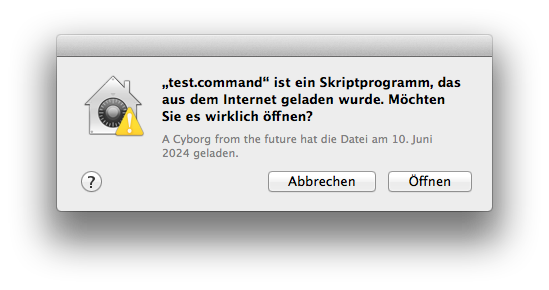You can copy an existing com.apple.quarantine attribute of an arbitrary file to a proxy file and then apply it to arbitrary other files. If you open certain file types (e.g. .txt files) the quarantine attribute will be ignored though.
Example:
xattr -p com.apple.quarantine /Users/user/dnscrypt-osxclient-1.0.12.dmg > quarantine.attr
xattr -w com.apple.quarantine "`cat quarantine.attr`" test.command
This will apply the data gathered from the .dmg to the .command file - including download date and download app of the original dmg file. The original download date/app of the .command won't be restored though.
Source: Using xattr to set the Mac OSX quarantine property
Format of the quarantine attribute:
flag;date;app_name;UUID;
- at least 0001-0003 rises the "Do you really want to open this file..." dialog, but 0062 doesn't.
- date (in Unix hexadecimal timestamp at least 00000000-1c000000 are unknown dates, an early date which works is 1d000000: 02 Jun 1985 05:47:44 GMT)
- app (any app name allowed)
- A UUID related with a file download which can be found in /Users/user/Library/Preferences/com.apple.LaunchServices.QuarantineEventsV2 (obviously facultative)
So using 0001;55555555;Klanomathiner; in the proxy file mentioned above and applying it to a file (in the example test.command) will rise:

or 0001;66666666;A Cyborg from the future;

After opening the file the first "flag" will be set to 0041 and reopening it won't rise anything.
With some bash/SQL-magic you may even recover the original UUID and the download date/app by querying for the file name in the sqlite database - which the file com.apple.LaunchServices.QuarantineEventsV2 represents - and restore the original quarantine attribute. But I'm too lazy to draw this up now. Someone else has done similar/related work already:
Read com.apple.quarantine
/usr/bin/xattr -p com.apple.quarantine "${file}"
Set com.apple.quarantine
application="cURL"
date=$(printf %x $(date +%s))
uuid=$(/usr/bin/uuidgen)
/usr/bin/xattr -w com.apple.quarantine "0002;${date};${application};${uuid}" "${file}"
Insert UUID into Database
download_url="http://example.com/file.zip"
date=$(($(date +%s) - 978307200))
/usr/bin/sqlite3 ~/Library/Preferences/com.apple.LaunchServices.QuarantineEventsV2 "INSERT INTO \"LSQuarantineEvent\" VALUES('${uuid}',${date},NULL,'${application}','${download_url}',NULL,NULL,0,NULL,'${url}',NULL);"
Check if UUID exists in Database
/usr/bin/sqlite3 ~/Library/Preferences/com.apple.LaunchServices.QuarantineEventsV2 "SELECT * FROM LSQuarantineEvent WHERE LSQuarantineEventIdentifier == '${uuid}'"


